Neighbours aghast at 'deforestation' of Tewin lands
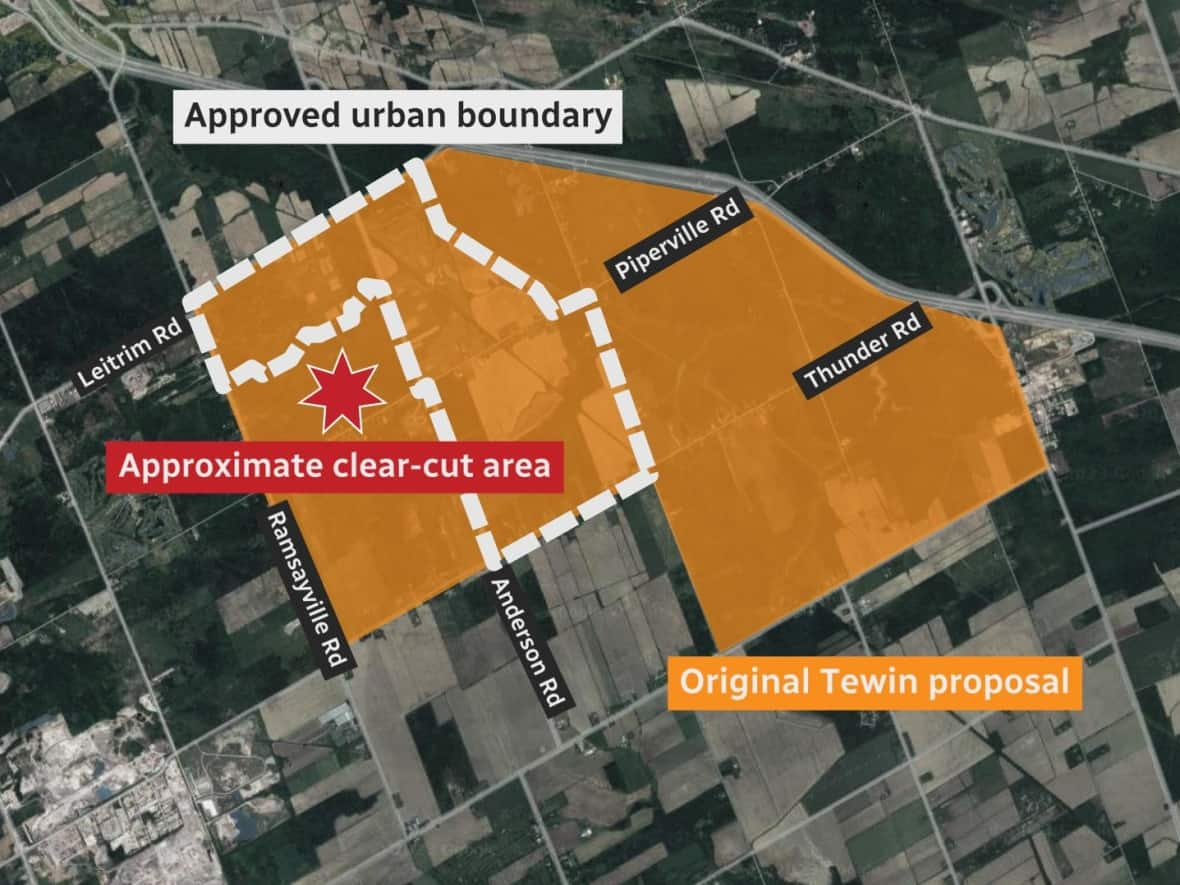
UPDATE: After this story was published, the acting general manager of planning sent a memo to city council stating staff were made aware of the tree cutting on Feb. 17 and issued a stop-work order under the tree-protection bylaw on Feb. 22 so the city could investigate.
The partners behind the future Ottawa suburb of Tewin say they've been cleaning up brush and trees felled by last year's wind storm on a parcel of land just outside the urban boundary, but aerial images appear to tell a different story.
Drone cameras sent up first by concerned neighbours and then CBC News show a swath of about 70 hectares has been clear-cut in recent weeks.
No permit was issued to remove the trees, according to the city.
Neighbours told CBC News they'd been catching whiffs of pine in the air and hearing a low hum at night, but couldn't see any activity because of a buffer of trees along Anderson, Piperville and Ramsayville roads.
We're talking hundreds and hundreds of trees. - Monica Brewer, nearby resident
It wasn't until someone flew a drone over the area and posted photos on a community Facebook group in mid-February that there was widespread alarm and an outcry at a Carlsbad Springs Community Association meeting.
"It was just devastating," said Monica Brewer, whose family has lived in the area for about 50 years. "We're not talking 10 trees. We're talking hundreds and hundreds of trees."
The property north of Piperville Road is owned by the Algonquins of Ontario (AOO). It lies within the larger area in the city's rural southeast where the AOO and its partner Taggart Group have proposed a large community that would be rooted in Algonquin values and make Ottawa a world leader in developing walkable, sustainable communities.
City council ultimately voted to redraw Ottawa's urban boundary — the urban-rural divide that delineates where development can occur — to include some of the AOO and Taggart lands so Tewin could begin building.
The parcel where trees have been cut falls just outside the urban area and is labelled "unevaluated wetlands" in the city's mapping database. The land is also subject to the city's new tree protection bylaw.
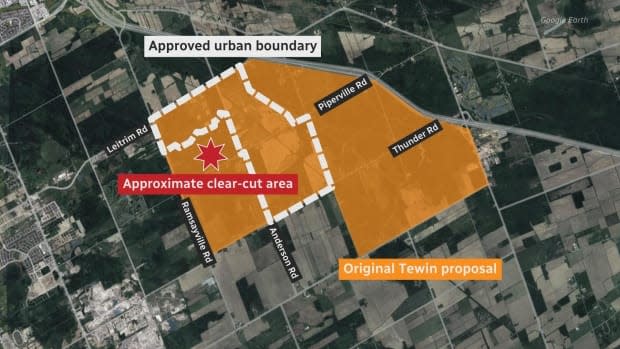
Hundreds of logs piled up
CBC News obtained its own drone footage this week that confirms rural land has been cleared in a broad swath stretching between Ramsayville and Anderson, and north to a creek that forms the new urban boundary.
WATCH | A drone view of the area:
Hundreds of logs sit in piles, awaiting heavy machinery to lift them onto trucks. Smaller trees are arranged in dozens of tidy bunches.
Google satellite imagery shows the area had previously been covered in greenery in the summer months and included some wet areas. The National Capital Commission's mapping of the tree canopy also showed the property covered in trees.
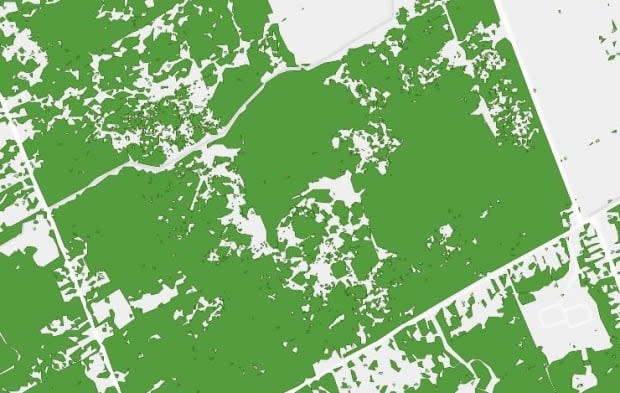
The parcel was among the approximately 1,600 hectares the AOO purchased from the Ontario government in January 2020 under the province's duty to consult.
Wendy Jocko, chief of Algonquins of Pikwakanagan First Nation, said she was unavailable for an interview but explained by email that debris from the derecho in 2022 needed to be cleaned up.
"The area in question was farmed several decades ago, and since then, a mix of grass, brush and trees have grown on the agricultural land," she wrote.
"Of note, this area remains outside of the urban boundary, is not designated floodplain or wetland, and suffered severe damage last May as a result of the storm."
Jocko said areas with less severe damage were left as untouched as possible.
"We were advised by the contractor that selective cutting in the worst-hit areas was not possible for safety reasons due to the extent of the damage," wrote Jocko. "City of Ottawa staff were made aware of the clean-up."
When reached by phone, the contractor, Ottawa Cedar and Lumber Inc., would not comment for this story.
An emailed statement from Taggart Group's Michelle Taggart echoed Jocko's comments that the lands were formerly farmed and "shrubs, grasses and some immature trees" have since regrown.
"We were advised by our environmental consultant … that the bylaws allow for the removal of trees in preparation for farming in the rural area," it said.
Tree protection bylaw
CBC News asked the City of Ottawa on Feb. 24 for an interview to confirm whether a permit had been issued to allow for the destruction of trees and if city staff knew about the cutting ahead of time.
"The city continues to review the matter. We can confirm that a tree permit was not issued for this location," wrote Don Herweyer, interim general manager of planning, real estate and economic development, in an email Tuesday.
The city's tree protection bylaw that came into effect on Jan. 1, 2021, states that "no person shall injure or destroy or permit the injury or destruction of a tree" over 10 centimetres in diameter on many private properties greater than one hectare unless the general manager has issued a permit.
The bylaw includes maps of many woodland areas on either side of the new urban boundary where future homes are expected — including the Tewin parcel.
Seven exemptions exist that would allow a tree to be destroyed without a permit, including if the tree "is an immediate threat to public health and safety" or "the injury or destruction is a normal farm practice carried out as part of an agricultural operation by a farming business."
According to Herweyer, city staff are currently "reviewing if a permit was required" in this case.
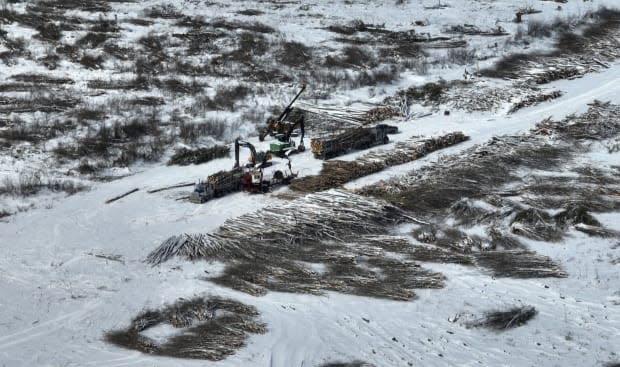
The South Nation Conservation Authority, whose watershed includes Tewin, has no jurisdiction over tree cutting and can only regulate wetlands that have been officially designated as "provincially significant".
When city council was debating whether to include Tewin as an entirely new suburb in 2020 and 2021, city staff warned they hadn't properly assessed soil conditions or natural features there.
Council's approval in 2021 hinged on a long list of studies taking place in the area.
No heads-up for neighbours
What most upsets residents is that they received no warning of the tree cutting despite having been promised regular updates and consultation by the AOO and Taggart.
"When there's work to be done, the community needs to know ahead of time," said Adrian Becea, president of the Carlsbad Springs Community Association.
"It caused a lot of turmoil in the community. We don't need this in the community, especially for the duration of time that a development of this size is going to take."

Brewer was surprised the cutting took place in an area where neighbours didn't expect to see development for many years, because that land is not yet included in the urban boundary.
She said neighbours understood the development was going to go ahead and were interested in the promise of a zero-carbon community. (Taggart and AOO had promised to follow a framework called One Planet Living).
"It was supposed to be a very special project," Brewer said. "Before the environmental assessments are finished, the first thing that's done is complete deforestation. There's no words for it."
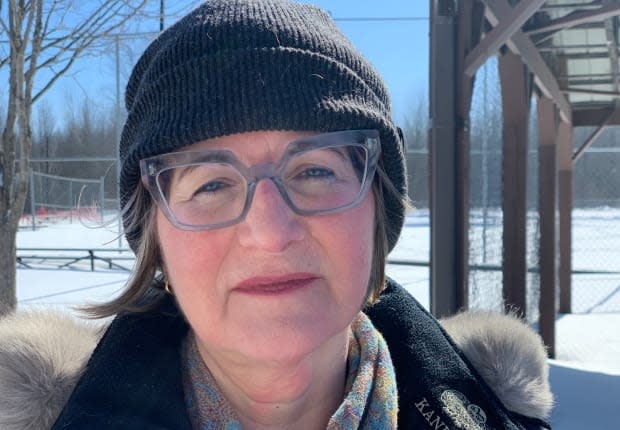
Jocko pointed out that Tewin is much larger than that parcel.
"There are hundreds of acres of mature forests in the Tewin area that will be protected and enhanced and will be a cornerstone of the Tewin community and its commitment to sustainability and environmental preservation," she wrote.
Taggart added her company and the AOO would keep residents better informed in the future, given the public's interest.
Other residents told CBC they expect the suburb of Findlay Creek to the west will inevitably spread toward the future Tewin.
Last fall, Ontario municipal affairs and housing minister Steve Clark approved expanding Ottawa's urban boundary in Findlay Creek, which would bring new homes to within three kilometres of the Tewin land where the trees were cut.


